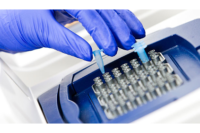Rapid testing for pathogens in meat and poultry plants is crucial for minimizing the risk of foodborne illness, protein contamination and spoilage. Yet, getting accurate readings can be difficult.
Such factors as tester errors and general ignorance about best practices often result in imprecision, analysts say. Elaine Vanier, technical manager of supply chain food safety audits at NSF International, says common mistakes include:
- checking only for the presence of a class of organism rather than a specific pathogen,
- following a reactive rather than preventive strategy by only testing finished products,
- failing to integrate finished product tests with environmental and equipment tests to validate cleaning and sanitation procedures
- and neglecting to consider the impact of pathogen-control strategies, such as antimicrobial washes and sanitizing, on test results.
Additional errors include:
- neglecting to consider the impact of the sampling collection method or location on the validity of results
- lacking the necessary expertise to collect, test, correctly read and interpret tests
- and failing to embrace corrective action and continuous improvement, which includes reviewing and optimizing testing programs and food-safety systems on an ongoing basis, she says.
“Proper actions will confirm what is being done is sound and will provide an outcome that ensures and promotes food safety in the wider context,” says Vanier, of the Ann Arbor, Mich.-based certification organization that does supply chain assurance and second- and third-party auditing. “The ability to rapidly detect viable pathogens along the production chain is essential for determining intervention and control strategies.”
Expertise can be elusive
Testers who lack the proper training pose one of the biggest challenges in getting accurate results quickly, says John Marcy, professor and poultry processing specialist in the University of Arkansas’ Division of Agriculture, in Little Rock. “Workers need to know the consequences of not testing correctly and completely and to not take testing shortcuts, which can occur when they don’t fully understand the mechanics of the system,” Marcy says.
Someone rushing to complete pathogen testing in poultry, for instance, may not wait until incubation temperatures are at proper levels, which can result in false negatives, he says. “It is important that processors use accredited labs that have checks and balances and documentation redundancies to help prevent things from going wrong,” Marcy says. “It is critical that the testers know what they are doing and the hazards of taking shortcuts.”
Many poultry plants engage outside firms to rapidly test because they lack the economies of scale to make in-house testing cost effective, Marcy says. “Operators also often lack workers who possess the proper skill set to effectively run the labs, often because the companies are unwilling to pay what it takes to hire personnel who know the methodologies,” he says. “The outside parties do enough tests that they can afford to pay such persons, who typically have college degrees and the proper training and experience. You just can’t pull people off the street to do the work.”
Accurate testing takes time
Common tests for indicator organisms and pathogens include total plate count (or aerobic plate count), which provides information on the total population of bacteria present, Vanier says. Counts above a certain threshold typically suggest sanitation of the specific environment or equipment is ineffective or being performed improperly, she says.
Tests also track coliforms, a diverse group of bacteria found in the environment the digestive tracts of animals along with enterobacteriaceae, a host of bacteria that includes such pathogens as Salmonella, Vanier says. Tests results for enterobacteriaceae and coliform often indicate improper cleaning, unsanitary conditions and post-process contamination, she says.
Vanier says an effective rapid testing program will establish proper sampling procedures and frequency, appropriate test methods, accurate results interpretation and corrective action procedures.
Most processors, meanwhile, are expending “tremendous resources” on Hazard Analysis Critical Control Points (HACCP) strategies to ensure their intervention methods are effective, says Carmen Gomes, associate director of the Virtual Reality Applications Center and associate professor in the Department of Mechanical Engineering, Department of Agricultural and Biosystems Engineering and Department of Food Science and Human Nutrition at Iowa State University in Ames. “The steps are mostly preventive to avoid pathogens in their processing plants,” she says, adding that operators then conduct intensive cleanings if testing finds an increase in microorganism load numbers.
Be stringent for success
The need for pre-enrichment of a food or food surface sample prior to testing for pathogens limits how quickly processors can conduct tests and generate accurate results, Gomes says. Pre-enrichment of up to 48 hours is necessary to allow for the concentration and amplification of bacteria prior to a qualitative detection step, she says, adding that the detection step itself is usually rapid and typically occurs in less than one hour.
“Many of the so-called ‘rapid’ commercial tests require a further confirmatory test which can take days to positively identify a pathogenic strain,” Gomes adds.
Processors often follow guidelines from the U.S. Department of Agriculture’s Food Safety and Inspection Service (FSIS) for sampling and testing, she says. Such measures include tracking total viable counts (TVC), which gives a quantitative estimate of the concentration of microorganisms in a sample, including bacteria, yeast or mold spores; polymerase chain reaction (PCR), which identifies pathogenic organisms that are difficult to culture by detecting their DNA or RNA; and enzyme-linked immunosorbent assays (ELISA), which detect antibodies and other proteins in the blood. Such tests, however, are susceptible to errors and false readings and often require costly laboratory settings with highly trained personnel, Gomes says.
False negatives, which do not detect pathogens present in a sample, could lead to a disease outbreak, she says. A false positive, in which a pathogen is not present but the test still shows it, can cause significant processing delays, resulting in food waste.
Marcy says testing standards should be stringent and exceed governmental expectations. “Operators can’t just meet that requirement,” he says. “The government should be the low bar and we should all strive to be better than that. You can always do better.” NP




